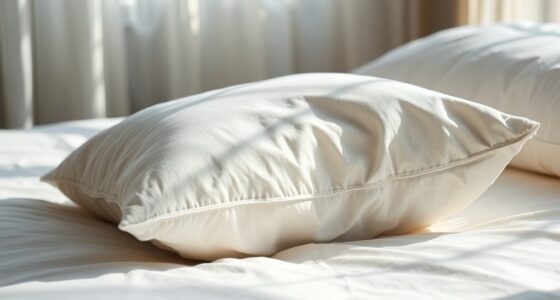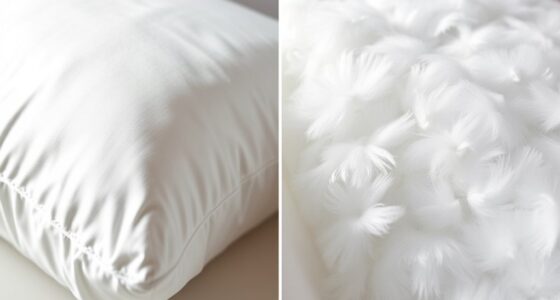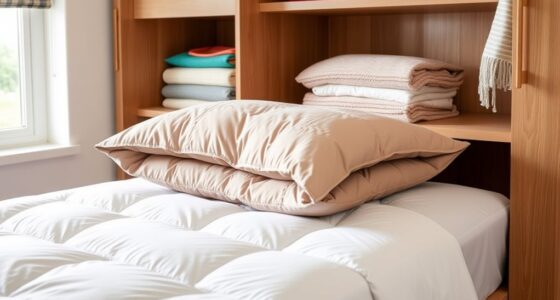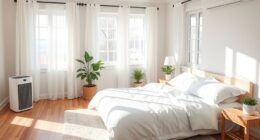To prevent dust mites and mold in your pillows, use hypoallergenic covers made from tightly woven fabrics like microfiber or cotton. Regularly wash pillows in hot water (at least 130°F) and replace those that aren’t washable. Keep your bedroom dry with a dehumidifier, vacuum often with a HEPA filter, and air out your pillows frequently. Maintaining a clean, well-ventilated space can considerably reduce allergens, helping you sleep better and breathe easier—discover more tips to create a healthier sleep environment.
Key Takeaways
- Use hypoallergenic pillow covers made from tightly woven fabrics to block dust mites and mold spores.
- Wash pillows and covers regularly in hot water (at least 130°F) to eliminate dust mites and reduce mold growth.
- Choose pillows made from hypoallergenic materials like memory foam or latex that resist dust mites and mold infiltration.
- Keep bedroom humidity below 50% with a dehumidifier to prevent mold and dust mite proliferation.
- Regularly vacuum bedding and pillow areas with a HEPA-filter vacuum to remove settled allergens.
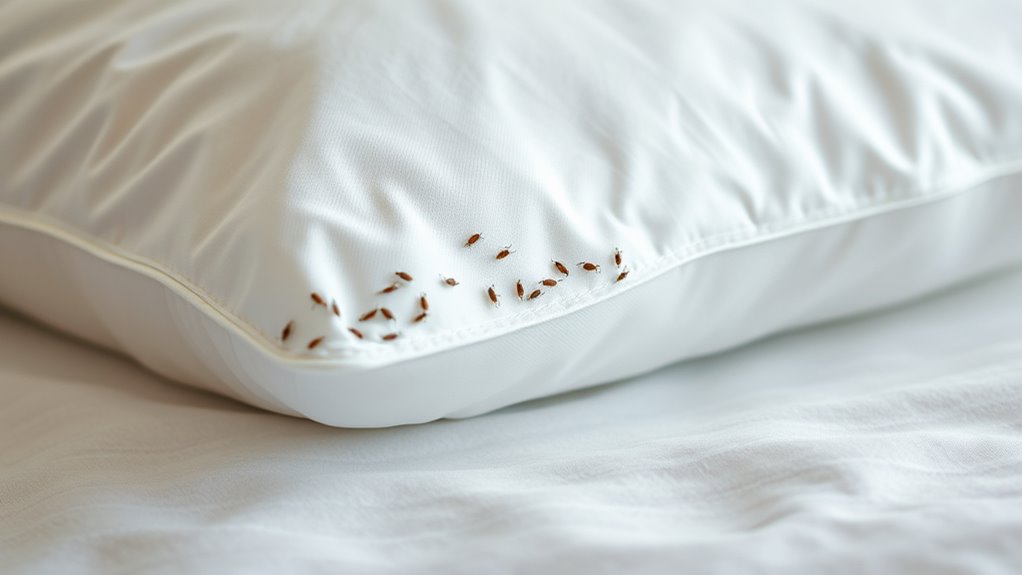
Many pillows contain allergens that can trigger allergic reactions or worsen respiratory issues. If you’re sensitive to dust mites, mold, or pet dander, taking steps to reduce these allergens in your sleeping environment is essential. One effective way to do this is by investing in hypoallergenic pillow covers. These covers create a barrier that prevents dust mites and mold spores from penetrating the pillow, making it easier to breathe and sleep comfortably. When choosing hypoallergenic pillow covers, look for ones made from tightly woven fabrics like microfiber or tightly woven cotton, which block allergens more effectively. These covers are also washable, so you can regularly clean them to maintain a low allergen environment.
Invest in hypoallergenic pillow covers to block dust mites and mold, ensuring a cleaner, healthier sleep environment.
Beyond covers, selecting allergy-friendly pillow materials can considerably impact your allergy symptoms. Traditional pillows filled with feathers, down, or synthetic fibers often harbor dust mites and mold, especially if not cleaned or aired out properly. Instead, opt for pillows made from allergy-friendly materials such as memory foam, latex, or certain types of hypoallergenic polyester. These materials are less hospitable to dust mites and mold because they don’t trap moisture or provide a food source for allergens. Memory foam and latex also tend to be denser, making it harder for allergens to penetrate deep into the pillow. Additionally, choosing pillows with anti-mite properties can further reduce allergen exposure.
Maintaining a clean sleeping environment is equally important. Regularly washing your pillow and pillow covers in hot water (at least 130°F or 54°C) kills dust mites and removes mold spores. If your pillow isn’t machine washable, consider replacing it periodically. Additionally, using a dehumidifier in your bedroom can reduce moisture levels, discouraging mold growth and dust mite proliferation. Keeping your bedding and pillow area free from dust and pet dander by vacuuming regularly with a HEPA-filter vacuum also helps in reducing allergen buildup.
Another tip is to avoid using feather or down pillows if you’re allergy-prone, as these materials tend to trap more allergens. Instead, choose synthetic or latex pillows that are designed to be hypoallergenic. Remember, the key to preventing dust mites and mold from affecting your sleep is consistency—regular cleaning, proper ventilation, and choosing the right materials make a noticeable difference. By combining hypoallergenic pillow covers with allergy-friendly materials, you create a safer, more comfortable sleep environment, helping you wake up refreshed and free from allergy symptoms.
Frequently Asked Questions
How Often Should I Replace My Pillows to Reduce Allergens?
You should replace your pillows every 1 to 2 years to reduce allergen buildup. Over time, pillows accumulate dust mites, mold, and other allergens that can trigger allergies or asthma. A shorter pillow lifespan helps prevent allergen accumulation and maintains better sleep quality. Regularly washing your pillows also helps, but ultimately, replacing them on schedule is the best way to keep allergens at bay and ensure a healthier sleeping environment.
Are Hypoallergenic Pillow Covers Effective Against Dust Mites?
Think of hypoallergenic pillow covers as shields guarding your sleep. They’re crafted from hypoallergenic fabrics, acting as sturdy dust mite barriers that keep allergens at bay. Yes, these covers are effective—they trap dust mites and mold spores, preventing them from invading your pillow and causing allergies. By using them, you create a fortress of freshness, allowing you to rest peacefully and breathe easier every night.
Can Natural Materials Prevent Mold Growth in Pillows?
Natural materials can help prevent mold growth in pillows when you choose the right fabric. Natural fabric benefits include breathability and moisture-wicking, which keep your pillow dry and discourage mold. Consider material selection carefully—look for options like organic cotton or wool, which resist mold better than synthetic fibers. Regularly washing and thoroughly drying your pillows also play a key role in mold prevention, ensuring a healthier sleep environment.
Do Washing Temperature and Detergent Type Affect Allergen Removal?
Washing techniques and detergent efficacy play a big role in removing allergens from your pillows. Using hot water, ideally at least 130°F, helps kill dust mites and mold spores effectively. Choose a high-quality detergent designed to break down allergens and mold. Be sure to follow the care label instructions, and consider adding an allergen-eliminating booster. Proper washing guarantees your pillows stay fresh, clean, and allergen-free.
What Are the Signs of Allergic Reactions Caused by Pillows?
When it comes to pillow allergy symptoms, you’re often flying blind without knowing it. Identifying allergic reactions can be tricky, but watch for sneezing, itchy eyes, runny nose, or skin rashes after sleep. You might also experience congestion or difficulty breathing. If these signs persist, it’s a clear indicator that your pillow could be causing an allergic reaction. Recognizing these symptoms early helps you take action before it worsens.
Conclusion
To keep your pillows allergen-free, stay vigilant, stay clean, and stay protected. Regularly wash your pillows, use allergen-proof covers, and keep your sleeping area dry. By taking these simple steps, you reduce dust mites, mold, and other allergens. Stay proactive, stay comfortable, and enjoy restful, allergy-free sleep every night. Your health depends on your habits, so make these choices today for a cleaner, healthier tomorrow.



